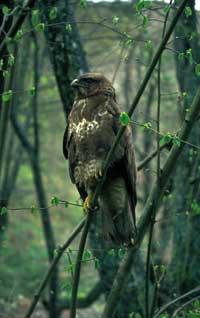Common eaglet, watch

Traveling through the Basque Country, we have been able to see on numerous occasions a brown bird that is in a striking place on the road. Although it seems to us that he is very unhappy with our fast life, he looks from the pile post, the tree or the force of light that is, trying to see the hunting pieces. His technique is to remain still in a place with a wide perspective, being able to spend hours in this effort until some belly is perceived.
The common hawk ( Buteo buteo) is a medium-sized predator. As with many birds of prey, there is a dimorphism between sexes in size and the female is greater than the male. Thus, the female has between 700 and 1,200 grams of weight and an approximate length of 56 cm, while the male only has between 550-850 g and 50 cm. The flight width usually varies between 113-140 cm. The plumage can be very variable, dark brown to whitish brown.

The back is uniformly brown and although the bottom is lighter, the stain is dark. In the tail you can distinguish between 7-10 narrow dark lines and the last fingerprint of the tip is thicker. The wax of the legs and beak is yellow and the eyes brown or brownish-yellow. Colouring shows no differences between sexes.
View from below in the air, shows a short hill and wide wings. The tail, also wide and circular, separates it from milanos of similar size (which are hanged). The tips of the wings are black, but the feathers are whitish. The carpal joint (corresponding to the wrist) is dark. The way to fly is gliding and quite quiet. Through the currents of wind rises turning with large circles and with few blows of fin. With enough skill, you can sometimes stay still in the air.
It is a forest and riverside animal that offers open spaces for hunting. He likes sandwiches interspersed with farmland, meadows, farmland, open areas and mixed forests. The landscape of Euskal Herria, therefore, is appropriate for this bird and from the coast to the high peaks, extending to the southern groves.
This carnivorous animal is not specialized in a single type of hunt and has a wide spectrum of food. You can eat micromammals, rabbits, lizards and snakes, amphibians, birds, insects such as orthoptera and coleoptera, worms or slaughter, among others.
The common hawks have an approximate area of 6-7 square kilometers. To claim ownership of the territory, they revolve in the sky and limit: “piuuu”, “piuuu”. In late winter, around February, you can see them making a bridal flight in the sky. The pair begins to rotate around each other, planning, fast tours together, vertical descents closing the wings and other special movements.
They have only one breeding and in spring, starting in March. The nest, almost always in some big tree of the forest, and sometimes in some rock. In some cases it is the renewal of an old nest made by some courageous or simply theft. The size is usually large and the work of the couple is to collect the branches and material they need. They are lined with moss and grass and decorated with green branches around.
In this nest the female will place from 2 to 4 white eggs dotted with brown red. On these 56 x 44 mm eggs the female will pass from 33 to 38 days and leaving hunting occasionally, the male broken in the txitada. Chickens at birth weigh about 45 grams and have white feathers. The female spends the first 15 days without barely moving from the nest, but from there she will have to start hunting along with the male to relax the insatiable chickens. However, smaller offspring often die. After three weeks they will begin to stand upright and at 30 days they will be dressed in feather. With 45-55 days and adult look will leave the nest. It reproduces for the first time at 2-3 years, with an average age of 4-5 years.

As for distribution, in Europe it is common. Except in Ireland and Northern Europe, it can be seen throughout the continent and, being a partial migrant, those from the North will arrive to the South to spend the winter. From Euskal Herria, in late August and during the first two weeks of October, most common hawks are passed separately or in small groups.
The last pass in early November. These northern chaparrones head towards the western and Mediterranean region and winter alongside the sedentary attics. Some, although headed to the east and southeast of Africa, others remain in the Basque Country. These winterers usually have a lighter color than the locals.
In addition to those observed during migration, in the Basque Country it is common nesting and the current situation of the species is good. It lives especially in the forests and forests of the Cantabrian and Sub-Cantabrian region. In the southern direction, in the Mediterranean region it can only be found in forests, agricultural lands and cultivated fields, but not in the Rioja Alavesa and the Ribera Navarra, desolate.
According to the UK study of common hawks, the most important factors that condition the presence of this species are the abundance of game pieces, the availability of suitable places for nesting and habitat stability. Among the harmful factors for the species are organochlorine pesticides and diseases that affected rabbit populations.
On the other hand, the decrease in the number of fatalities by shot and, in general, the greatest respect, have done a great favor in recent years. Therefore, both in neighboring countries and ours, populations have increased. So, it is much easier than 30 years ago to see this elegant predator spying in our sky or on the edge of the road.
Species: Buteo family buteo: |





